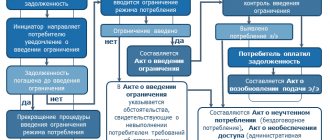Even if an electric meter is not installed in your residential premises, you will still have to pay for electricity (regardless of whether you consume the resource or not). The fee is set by region according to consumption standards.
This article provides information on how to pay for electricity if there is no meter (it is damaged, stolen, broken) or if the user does not allow employees of the energy sales company to take readings from the meter.
How to pay for electricity without a meter?
When a consumer has an electric meter installed, there are no questions about how the fee is calculated. Simply, the amount of kWh spent (according to the electric meter readings) should be multiplied by the tariff that is established in the region. The result obtained will be the amount that needs to be paid for electricity.
It is more difficult to determine how electricity charges are calculated without a meter. Similar situations include cases when there is no electric meter, or when there is one, but:
- Employees of the energy sales company are not allowed to the electric meter to check its integrity and take readings;
- The readings for the reporting period were not transferred to the energy sales company (in accordance with the established procedure);
- The device is faulty (broken or the verification period has expired);
- During the verification, it was determined that the device was damaged intentionally.
Each of the above cases is described in detail in the Rules for the provision of public services (hereinafter referred to as the Rules). There is also a method for calculating fees for electricity services without metering devices.
This document was approved by the Government of the Russian Federation by its Resolution No. 354 of May 6, 2011. “On the provision of utility services to owners and users of premises in apartment buildings and residential buildings.” After its entry into force, this document underwent many changes and improvements.
In the context of these rules, we will analyze in detail the different options for paying for electricity without a meter.
What is ODN and how is it calculated?
ODN - general house needs. Each apartment building receives a certain amount of utility resources, the bulk of which is consumed by residents. Some of the resources go to maintaining the house and maintaining common property. Not only utilities inside the apartment are paid, but also utilities used for general house needs.
The amount of one tax charge for electricity may include costs for:
- Lighting of common areas (staircases, vestibules and entrance areas);
- Energy consumed by intercoms;
- Energy consumed by elevators;
- Energy consumed by other electrical equipment; Used for general house needs (for example, surveillance cameras, pumps pumping water to the upper floors, automatic heat control system, etc.).
Each apartment building has an individual set of electrical equipment. Calculation of the consumed electricity at the ODN is carried out in accordance with the Decree of the Government of the Russian Federation No. 354 dated May 6, 2011, P.44:
- Based on the readings of collective metering devices; The expense for one-room registration is determined as the difference between the expense of a certain collective metering device and the total consumption of residential and non-residential premises, then divided by the total area of such premises, and then multiplied by the individual area of each of them.
- In the absence of a common house meter, the calculation is made according to the standard. If the electricity consumption for ODN is determined based on the ODN standard, then the value obtained by multiplying the standard by ODN and the area of the premises included in the common property in an apartment building is divided by the total area of the premises, and then multiplied by the individual area of each of them .
The electric meter is faulty: how to calculate the monthly payment?
If for some reason your meter is faulty (the verification period has expired, the device is broken during repairs, stopped working for other reasons, or is simply stolen) or is recognized as such during an inspection by a representative of the energy sales company, it is important to know how the payment for light is calculated in this case .
According to clause 59 of the Rules, the first thing that is determined is the moment of the event (from what time the electric meter is considered faulty/lost).
Such a moment could be:
- the date the subscriber contacted the energy sales company with a statement about the malfunction/theft of the electricity meter;
- the date of drawing up the report regarding the malfunction of the electric meter, which is drawn up by an employee of the energy sales company during the inspection;
- expiration date of the electric meter inter-verification period.
If it is not possible to determine the exact date, then the payment period/month in which the “event” occurred is taken as the “reference point”.
From this moment on, the user will be transferred to paying for electricity based on average monthly consumption (calculated based on the last 6 months). At the same time, according to the average monthly payments, the subscriber will be charged only for 3 months, and then he will be transferred to payments according to the standard, which is significantly more expensive. To reduce costs, you should install a new electricity meter promptly.
How to pay for electricity if the meter is damaged?
Here we will consider the option of how the payment for light is calculated in the case when the electric meter is damaged intentionally or electricity enters the house/apartment, completely bypassing the meter.
For the consumer, this situation is the most unfavorable. Here the calculation is carried out in accordance with clause 62 of the Rules.
If, during the inspection, the inspector discovered that the electric meter was damaged intentionally and takes into account the consumed kilowatts for the benefit of the subscriber, or electricity was supplied to the apartment/house bypassing the meter altogether, then severe measures will be taken against such a consumer. In this case:
- The inspector inspects the premises of the apartment/house (in this case he has the right to do this) and records the number and power of all available electrical appliances;
- After this, the daily electricity consumption is calculated (provided that absolutely all electrical appliances work constantly);
- It is calculated how much energy the household consumes in this mode over the last 6 months;
- The total number of kilowatts received is multiplied by the tariff. The result obtained is the amount that the subscriber will be charged for payment.
Read more: How the first pension is paid for an incomplete month
The amounts of such accruals are several times higher than the standard amounts of payment for electricity according to the meter.
It should be noted that the payment for light in a similar way (based on the maximum possible consumption) will be charged until the user eliminates the malfunctions and violations.
It is important to remember that if representatives of the electricity network visited you with an inspection less than 6 months ago, and such an inspection did not reveal any violations, then, based on the maximum possible consumption, the calculation of electricity charges will be carried out from the date of the previous visit of representatives of the energy sales company.
How much do they pay for electricity without a meter?
Everyone decides for themselves whether to pay according to the meter or according to the standards. According to the standards, it is more profitable to pay if there are many more people living in a residential building than are registered. In addition to the number of registered ones, the following is taken into account:
- number of rooms;
- presence of an electric stove;
- urban or rural;
- total area.
The most common coefficient for calculation is 1.5. This is due to an increase in total power due to an increase in the number of electrical appliances in the premises. When calculating the amount for electricity, it is necessary to multiply the standard by the number of residents, by the tariff and by the increasing factor.
Example. A family of three lives in a one-room apartment in Moscow. They pay according to the standard because the meter is broken. The stove in the house is gas. Amounts for electricity per month = 45x3x5.47x1.5 = 1107 rubles. If the same family connects electricity, bypassing the meter, the amount will increase 10 times, instead of one and a half, and will be 7,384 rubles.
In order not to pay the increasing factor, you need a certificate stating that the meter cannot be installed for technical reasons or the house is recognized as unsafe. In this case, the same family will pay the amount without an increasing factor, which is 738 rubles.
For residents of rural areas, when calculating, 90 kWh per person is added to the standard. When calculating electricity consumption, the standard per person is taken . For Moscow, the payment is 45x5.47 and equals 246 rubles.
For a rural region, in addition to the standards, the calculation of electricity that the homeowner spends on lighting outbuildings and keeping farm animals is added.
For example, one person lives in a rural house. He has a gas stove, a 4-square-meter barn that is separately lit, and he has a cow. In this case, the electricity consumption standards for the same Moscow region will be calculated as follows: (5.47x14x4+(45+0.83)x5.47)x 1.5= 834 rubles.
This formula is based on the following calculation indicators:
- When lighting outbuildings, 14 kWh per month is added to the standard for each square meter of premises, unless a separate meter is installed for them.
- For keeping animals, the norms are calculated for each head per month: for cows - 0.83, for pigs - 0.83, and for birds 0.33 kW/hour. All other animals – 0.17 kW/hour.
The amount turns out to be impressive, which is why most citizens voluntarily install meters . It is especially beneficial to purchase metering devices for those who have more people registered in their house than actually live there. The presence of centralized hot water supply is also taken into account.
In apartment buildings where there is none, electric boilers are widely used. This leads to an increase in the standard, since electricity costs in such apartments are always higher (what is the average electricity consumption in an apartment per month?).
There is no electricity meter at all: how to pay for electricity?
Of course, housing began to be equipped with electricity meters a very long time ago (en masse back in Soviet times), but to this day you can find premises where there are no such meters. This often occurs in apartments converted from former dormitories, etc.
If there is no electricity meter in the apartment/house, electricity charges will be charged according to the standard. The methodology is described in paragraph 42 of the Rules. Here three indicators are taken into account, namely:
- the number of persons who permanently/temporarily reside in a particular premises;
- electricity consumption standard (set separately for each region of the country by local authorities);
- electricity tariff that applies to a specific type of consumer.
By multiplying these values, you get the amount that is billed to the subscriber for payment.
If we consider how profitable such a payment will be, we should take into account the number of persons officially registered in the apartment/house:
- if there are actually more people living in an apartment/house than registered, then paying for electricity according to the standard may be more profitable;
- If there are actually fewer people living in an apartment/house than officially registered, then it is more profitable to pay for electricity according to the readings of the electric meter.
For greater specificity, it is advisable to find a decision from the tariff authority (in the region of residence), which approved consumption standards.
What do consumption standards depend on?
Electricity consumption rates depend on the following points:
- number of rooms in the house/apartment;
- type of installed stove (gas or electric);
- number of residents (if 1 person is registered, then the consumption rate will be greater than, for example, for one of the 3 registered). At the same time, the management company (HOA) has the right to control how many people actually live in a particular apartment. After such verification, the confirmed number of residents will appear in the calculations of electricity charges according to the standards.
Additional Information
In recent years, the Russian government has been introducing measures aimed at 100% equipping residential premises with meters for electricity consumption. In order to further motivate consumers to switch to paying according to the electric meter, and not according to the standard, it is planned to gradually increase them (standards). Depending on the region, the increase will be 10-20%. In addition to the already common increase in electricity tariffs (usually 5-10% per year), the difference becomes more than significant.
Summarizing the above, it can be argued that electricity without a meter will cost consumers more and more. It is advisable to think about equipping your home with an electricity meter today. This way, you can avoid overpaying every month, but pay only for the number of kilowatts that were actually used.
Calculation of energy consumption by meter
For the population living in private houses and apartments and equipped with metering elements, it is quite easy to calculate the electricity consumed over a certain period of time. To do this, you just need to look at the readings for the current month, subtract the readings for the previous month from them and multiply by the current tariff. In this case, you need to be careful because only the numbers indicated before the decimal point are taken into account. We described in detail how to take readings from an electric meter in a separate article.
If there is an accounting element and an agreement has been signed with the supplier on a two-tariff or multi-tariff consumption regime, then a special calculation is carried out. The cost of each kilowatt/hour depends on the time of day. During the day, the price of electricity will be more expensive, and at night it will be cheaper. Moreover, this meter is a modern electronic device that records consumption and displays it on the display. Without difficulty, at any time it is possible to view separately the readings for daytime and nighttime, and then calculate in the same way by multiplying the difference by the corresponding tariff. The cost of one kWh directly depends on the type of residential premises:
- with gas stove;
- with electric stove.
For houses located in a village or town, the standards may also differ.
Prices for legal entities and enterprises differ from prices for the population and depend on the total market trading for a particular region. You can view this information on the website of the guaranteeing electricity supplier.
How to use the Voice Control service?
When you contact the Contact Center by phone +7 (499) 550-9-550, you can independently, without waiting for an operator’s response, transfer meter readings or obtain the necessary information. To do this, in the voice menu after the question “Tell me what interests you?” you need to say your question.
You can read the instructions for operating the voice service on the website of PJSC Mosenergosbyt.
Attention!
The personal account number and meter readings must be given strictly in one digit. You can enter data using the telephone keys. To undergo automatic identification, we recommend linking your phone number to your Personal Account in the Client’s Personal Account.
Calculation without a meter (according to the standard)
If, according to the meter, electricity consumption is calculated and paid for without difficulty, then in the case where there is no meter, the situation and the calculation formula changes radically. For a private house or residential premises in an apartment building, there is a standard that depends on the following factors:
- the number of rooms, while their size in area must be taken into account;
- the presence or absence of an electric stove;
- the number of residents registered in the living space.
Read more: How to make a donation box with your own hands
It is generally accepted that these figures are derived from average statistical values, but, unfortunately, as practice shows, they are far from reality.
In 2021, a coefficient of 1.5 began to be taken into account for the standard fee, and this is due, as officials say, to an increase in the number of electrical appliances and, as a consequence, the total power. In this regard, the consumption of unmetered electricity has become so unprofitable that it looks more like penalties than payment according to the standard.
Here is an example of real inferred consumption. For a two-room apartment in one of the high-rise buildings, in which two people are officially registered and there is an electric stove. The standard for one person is 91 kW/h. in order to calculate the monthly payment you need to:
- Take the standard of 91 kW/h established by electricity suppliers and officials, multiply it by the number of residents, that is, 2.
- Multiply by the current tariff of 3.53 rubles per 1 kilowatt/hour.
- And multiply again by an increasing factor of 1.5.
This results in a rather impressive amount of 964 rubles.
Why do we need an average electricity tariff and what does it depend on?
The consumption standard is a certain amount of electricity, calculated not for 1 sq. m, but for one person. This value is regulated at the legislative level. This indicator is necessary for several reasons:
- household electricity costs are reduced;
- it becomes possible to pay for electricity on an accountable basis;
- The responsibility of management companies is growing.
When calculating the social standard, it does not take into account where electricity is spent: for household needs or for commercial purposes. According to the standard, energy is considered to be sufficient for minimal needs: the use of a limited number of basic household appliances, for example, an iron and a kettle, as well as lighting the house at night.
For northern regions, this standard is usually an order of magnitude higher, since the dark period of the day and the amount of energy that may be needed for heating increase there. The standard indicators depend on the number of people living, the area of living space, and for apartment buildings also on the load from electrical appliances and the number of apartments.
also focuses on the presence or absence of an electric stove . If the stove in a residential area is equipped with electricity, then the standard indicator is higher than in an apartment with gas stoves. For apartment buildings, the presence of elevator equipment in the entrance is also important when calculating.
Read more about how electricity consumption is calculated here.
Calculation for non-residential public premises
The calculation of electricity consumed for general house needs, abbreviated as ONE, was recently included in the utility bill as a separate line item. There have been changes since January 2021, but this figure cannot disappear anywhere, because someone has to pay for electricity. These needs include the following:
- Lighting of the entrance, staircase.
- Power supply for intercoms and video cameras, if they are installed to maintain order.
- Power supply for elevators.
- Other types of energy losses in networks of apartment buildings.
Naturally, the amount of payment directly depends on the meter readings, but their installation for monitoring networks of non-residential premises does not always exist. If there is a meter, then each apartment will pay an amount corresponding to the living area. Still, this option is calculated based on power and depends on it; the situation with metering without a meter is slightly different.
How are such calculations carried out if the accounting element does not exist? As with residential premises, there is a general standard established by the regional administration. After which this indicator is multiplied by the area of the common building and by the area of a single apartment in a multi-storey building. Each region has its own standard and it is the key value for calculating electricity consumption.
As you can see, at present, a working electric meter for both residential and public premises and consumers is the only effective method of paying less, and only for the energy actually used. Now you know how to calculate electricity according to the standard and understand how expensive it is to pay electricity bills without a meter!
It's simple! But how is electricity payment calculated without a meter? Current legislation reduces the variety of life situations to the following options:
- there is a meter, but its readings were not transmitted on time (in accordance with the established procedure)
- There is a meter, but it turned out to be faulty (it broke down, the verification period has expired)
- There is a meter, but representatives of the energy supply service provider are not allowed to see it
- there is a meter, but upon inspection it turned out that it was deliberately damaged
- Finally, there is simply no counter. And this situation is by no means uncommon.
How the fee for electricity supply service is calculated in each of these cases is described in detail in the Rules for the provision of utility services. This document was approved by government decree No. 354 of May 6, 2011.
How to calculate electricity consumption without a meter?
The government is of the view that below-average social standards encourage consumers to save. This indicator was introduced into the payment system for housing and communal services in 2013 only in some regions. At the moment it operates throughout Russia. The size of the standard is set depending on several factors: From the consumer group The presence of a social norm Geographical factor Rural area or city Type of stove Gas or electric Summation of several tariffs - Moscow In Moscow, special consumption standards have been established for citizens living alone, they depend on the equipment available in the residential premises . So, if there is a gas stove in the living room, electricity consumption should not exceed 50 kW/hour. If an electric stove is installed, this value increases to 80 kW/hour.
How much is the standard for 1 person in 2021?
This is a purely regional figure that differs depending on several factors. If we consider the largest cities of the Russian Federation, then for 2021 the indicators are as follows:
| City | One person living with a gas stove | One resident with an electric stove | Family with gas stove | Family with electric stove |
| Moscow | 50 | 80 | 45 | 70 |
| St. Petersburg | 78 | 111 | 48 | 63 |
| Chelyabinsk | 100 | 180 | 90 | 130 |
| Rostov | 113 | 182 | 82 | 90 |
| Vladimir | 100 | 190 | 75 | 130 |
| Krasnodar | 97 | 147 | 60 | 95 |
| Ekaterinburg | 102 | 160 | 63 | 100 |
In addition, there is a coefficient that differs depending on the reason for calculating tariffs according to the standard. The largest coefficient is if the meter is deliberately broken or the electricity is connected in such a way that it bypasses the meter.
Without an increased coefficient, only small categories of citizens who have a good reason not to install a meter or are unable to transfer data from it can pay.
Payment for electricity if there is no meter
There is a meter, but representatives of the energy sales company are not allowed to see it. How are electricity charges calculated? First, let's define what does “not allowed” mean? Often, electricity meters are installed directly in the apartment or in the vestibule, access to which from the landing is closed with a “good iron door” (c).
Read more: Is it possible to return wireless headphones to the store?
They do not travel at night or early in the morning. This means they have little chance of crossing paths with the apartment’s inhabitants. Just for such a case, the Rules for the Provision of Utility Services detail the procedure that the energy sales representative must follow in order to agree on the inspection time with the apartment owner.
What methods of transmitting evidence are there?
You can submit your testimony in any way convenient for you:
- through the Personal Account of a private client on the website of PJSC Mosenergosbyt;
- by phone Contact: +7 (499) 550-9-550 via voice control service;
- on the Moscow government services portal.
- through terminals for receiving readings installed in the branches of PJSC Mosenergosbyt and Multifunctional centers for providing state and municipal services;
- when paying through Qiwi and Sberbank terminals (subject to payment being made between the 15th and 26th).
What are the norms for electricity consumption per person in Russia in 2021?
It consists of having a certain amount of energy consumption per person. In Russia for 2021, the standard for electricity consumption is set at 350 kilowatts per hour for each person living in an apartment.
If more resources are used, payment will be made at an increased rate. Each subject of the Russian Federation has the right to establish an individual standard for electricity consumption.
The main condition is that it must differ from the value generally accepted at the federal level by 40% (no more).
How is electricity consumption paid without a meter?
- electricity consumption standard (set separately for each region of the country by local authorities);
- electricity tariff that applies to a specific type of consumer.
By multiplying these values, you get the amount that is billed to the subscriber for payment. If we consider how profitable such a payment will be, we should take into account the number of persons officially registered in the apartment/house:
- if there are actually more people living in an apartment/house than registered, then paying for electricity according to the standard may be more profitable;
- If there are actually fewer people living in an apartment/house than officially registered, then it is more profitable to pay for electricity according to the readings of the electric meter.
For greater specificity, it is advisable to find a decision from the tariff authority (in the region of residence), which approved consumption standards.
How is the electricity utility consumption standard regulated?
The standard for electricity consumption is set separately for each region of the Russian Federation. This figure is regulated by local governments. Legislative framework for consumption standards:
- Federal Law No. 190 “On Heat Supply”.
- Federal Law No. 614 “On the procedure for establishing and applying social norms for electricity consumption.”
- Federal Law No. 261 “On Electricity Supply”.
- Order of the Government of the Russian Federation No. 1650-r.
It is on these legislative acts that all other documents on standards that are adopted in the constituent entities of the Russian Federation are based. There is only one important rule: the standard established by the region cannot differ from the federal standard by more than 40%.
It is more profitable for the authorities for the population to install metering devices, and therefore for those who are calculated according to the standards, an increasing coefficient has been established. In most cases, paying for light according to the standards becomes unprofitable.
Electricity consumption standards per person without a meter
To reduce costs, you should install a new electricity meter promptly. Advertisement How to pay for electricity if the meter is damaged? Here we will consider the option of how the payment for light is calculated in the case when the electric meter is damaged intentionally or electricity enters the house/apartment, completely bypassing the meter.
For the consumer, this situation is the most unfavorable. Here the calculation is carried out in accordance with clause 62 of the Rules. If, during the inspection, the inspector discovered that the electric meter was damaged intentionally and takes into account the consumed kilowatts for the benefit of the subscriber, or electricity was supplied to the apartment/house bypassing the meter altogether, then severe measures will be taken against such a consumer.










